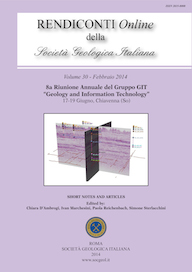
3D geological modelling and education: teaching geological cross sections with a 3D modelling software to improve spatial thinking skills in geoscience students
Fabrizio Berra (a), Fabrizio Felletti (a) & Michele Zucali (a)
(a) Università degli Studi di Milano, Department of Earth Sciences "A. Desio", Via Mangiagalli 34, 20133 Milano, Italy. E-mail: fabrizio.berra@unimi.it
Volume: 30/2014
Pages: 5-11
Abstract
The skill in “reading” two-dimension representations (typically geological maps) as symbolic images of the real world is critical for a geologist. Teachers have thus to face the difficulties that several students have when reading geological maps. Furthermore, when students fail, the consequence is often a frustration with the successive reject of the subject. The skill to understand 3D objects can be typically evaluated with the analyses of the geological cross sections produced by geology students.
Spatial thinking skills are related to two main facts: 1) a natural predisposition in the visualization of complex objects and 2) a good training to develop 3D visualization skills. Whereas in the first case the role of the teacher is often ancillary, in the second case, teachers need to find a way to improve 3D visualization skills with specific tools and specific exercises.
In the past, the supports for this educational training was provided by physical models or by perspective images. The development of 3D geological software packages recently provided tools for geological modeling that found applications in different fields of geology. In the academic formation, nevertheless, students learn the basic of 3D geological reconstruction with classical tools, whereas the use of 3D software packages is limited during their education and they mostly meet these tools for professional applications after their degree.
At the Earth Department of the Università degli Studi di Milano we introduced the educational use of a 3D modelling software (Move ™, produced by Midland Valley Exploration LTD and provided to our department in the frame of the Field Mapping Initiative) since the Bachelor courses (on voluntary basis), in order to stimulate the 3D visualization skills of the students. Move™ has been used on simple geological situations selected from a number of educational books: students were guided in the production of 3D geological models from digital raster images of simple geological maps, following all the process of data input and elaboration (including DTM production). 3D visualization at different step of the model development strongly improved the skill of the students in the visualization of geological volumes, speeding up the process of learning.
The feedback of this procedure has been strongly positive, with students that, after learning the basic use of this 3D modelling software, asked for the application of the method to real and more complex geological cases.
The use of 3D software packages for the modelling of geological bodies during the educational program potentially increased the precision in the geological mapping process, as the students were able to verify that also minor inaccuracies in data representation are strongly highlighted when geological data are handled in 3D models.
Keywords
Get Full Text